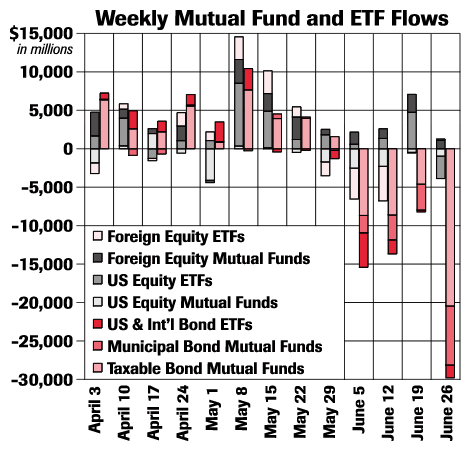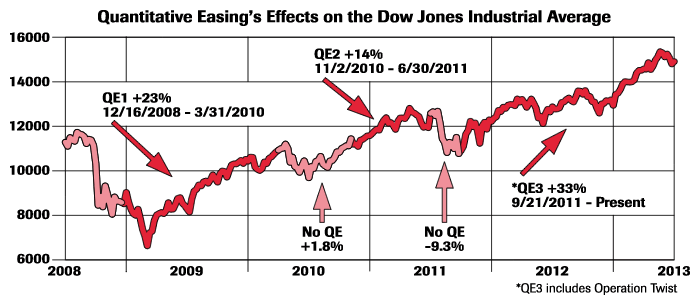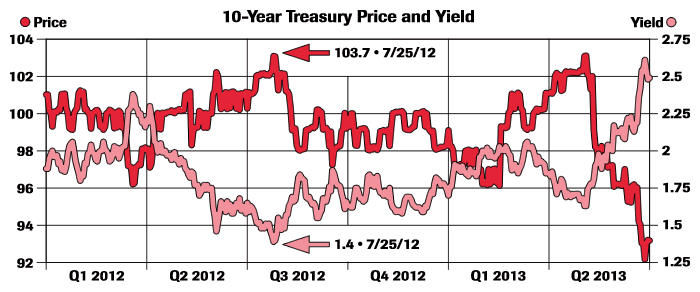2013 Q2 | The Return of the Summer Rally
 The results for the second quarter were good. We estimate that the domestic economy, supported by continued gains in housing and solid automobile sales, expanded at a rate of 1.7% in Q2 2013. The current economic expansion, which began in February 2009, is now 52 months old and approaching the average 57 month expansion in the post WWII period.
The results for the second quarter were good. We estimate that the domestic economy, supported by continued gains in housing and solid automobile sales, expanded at a rate of 1.7% in Q2 2013. The current economic expansion, which began in February 2009, is now 52 months old and approaching the average 57 month expansion in the post WWII period.
If we view this recovery in terms of employment, corporate profits, and gross domestic product growth, it is clear employment is the laggard. One possible explanation could be that our economy is becoming more productive, benefitting from investments in the information revolution, which are more widespread than previously thought. This development has lowered labor needs. Another explanation could be that corporations were surprised at the suddenness and the magnitude of the fall in the economy in 2008. The recent credit crisis was fueled by the bankruptcy of Lehman Brothers, which resulted in the bankruptcies of General Motors and Chrysler. These events pushed any number of companies to the brink of insolvency. Managements, shocked by the closing of credit markets, became very reluctant to add full-time employees, contributing to the current employment woes. The third factor potentially retarding employment levels is the uncertainty surrounding the implementation of the Affordable Care Act, which impacts 18% of the US economy. Many of the details of the program are unresolved.
At quarter end, the economy presented a mixed picture, but most economic series were in uptrends and we expect a continued 2% to 2.5% expansion in GDP for the balance of 2013. Also encouraging was the fact that strong sectors of the economy are early in the recovery cycle, including housing, autos and consumer durables. Industries that generally lag in a recovery, such as capital spending, raw material producers, and technology, are increasing only moderately at this point. This trend may explain the slower than average recovery to date, giving our economy the potential to extend the length of this expansion which would then continue well past the historic 57 month average expansion cycle.
Another critical variable in the economy is the Federal Reserve’s monetary policy. Without question, Fed Chairman Bernanke has played a pivotal role in navigating the US through the economic minefield of 2008-2009. Skillfully flooding our banking system with massive doses of liquidity in 2008, Bernanke narrowly avoided an economic collapse through his management of the credit crisis. Again in 2010, as President Obama’s stimulus plan faltered, the Fed initiated a series of monetary initiatives known as Quantitative Easing (“QE”) to stimulate the economy. The good news is the economy reacted favorably to these steps. However, as the accompanying chart (page 3) suggests, each time the Federal Reserve slowed easing, our economy faltered and more monetary stimulus was required to sustain the expansion. Since QE3 was initiated in September of 2012, the Fed has been adding $85 billion to the economy monthly, an amount more than sufficient to sustain growth. The excess liquidity has moved into financial markets, resulting in record low interest rates and record high prices for both bonds and stocks.
[blockquote4 align=”left|center|right” textalign=”left|center|right” width=”30%”] …Bernanke has played a pivotal role in navigating the US through the economic minefield of 2008-2009. [/blockquote4]Over the last few months, investors began focusing on a future after the QE programs have ended. In the last quarterly letter, we noted at the first signs of monetary tightening we expected a 5% correction in stock prices. Mr. Benanke spoke on May 22 and June 19, twice alluding to a tapering in the QE stimulus program. The markets promptly fell 5% after the June speech. We feel this was an overreaction and a market head-fake because the tightening is really a recognition that the recovery is gaining momentum, thus supporting stronger levels of profits, confirming the continuation of the recovery. Eventually, sustained increases in economic growth will put upward pressure on credit demands, which will signal the end of the recovery. We do not see this happening before 2015.
The extremely low levels of interest rates touched in the third quarter of 2012 have corrected as rates have risen from 1.4% in July of 2012 to a current level of 2.5% and resulted in a rapid bond price decline of 7% (note the resultant fund flows in the chart on the next page). We remain cautious with respect to the direction of future interest rates, as we anticipate rates will continue to rise as the expansion progresses. We suggest clients maintain bond exposure at the lowest levels recommended in investment policy statements, and that bond maturities remain short.
During the second quarter, the financial markets produced mixed results, positive for stocks and negative for bonds. Stocks, as measured by the S&P 500, managed a reasonable advance of 3.4% for the second quarter of 2013, bringing the first half results to a strong 14.0% gain, their best since 1998. Taken together, the first two quarters posted a well above average gain by historic standards. In fact, the S&P 500 hit a high on May 21 at 1,669, exceeding our upwardly revised year-end forecast of 1,650. Certainly investors should be pleased with the good results to date, however, further gains from current levels could entail higher levels of risk. This can be seen in the recent sharp increase in the volatility of daily equity price movements. In June, the market, as measured by the Dow Jones Industrial Average, moved more than 100 points daily in 16 of 20 trading days. We expect similar movements to be more common, unsettling some investors and presenting opportunities to others.
Although we fear the market volatility will be with us for some time, Hardesty Capital Management’s equity philosophy is grounded in identifying the undervalued stocks of established companies and pouncing on them when valuations are temporarily depressed. We believe strong companies have generally been able to benefit from a growing economy, and when we have been able to initiate or add to positions of companies that we have identified as attractive during periods of market turbulence, our returns have been quite satisfactory. Hence, we view the recent 5% correction in stock prices as an opportunity to add to our equity positions.
With a favorable economic backdrop, we are confident that projected earnings increases of 7% and 9% will be realized in 2013 and 2014, respectively. Accordingly, the stock market is selling at 15x this year’s and 13x next year’s anticipated earnings. We believe the price to earnings multiple should range between a low of 12x earnings and a high of 18x earnings in this environment, which suggests a favorable outlook for share prices in 2014.
 The fixed income market faces a more difficult challenge. Bond investors have enjoyed a 30 year decline in interest rates, resulting in an almost uninterrupted period of rising prices and positive returns. However, the yield on the 10 year Treasury bond has fallen from over 15% in September of 1981 to just 1.4% in June of 2012. At these very low interest rates, bond prices become much more sensitive to even a small change in the rate structure. As rates fell in 2008-2009, bond prices spiked upward. Investors responded by pouring large sums into bond funds, with many dollars finding their way into these funds after a 30 year bull market in fixed income investments. Now, in the spring of 2013, rates reversed and moved up, as you can see in the accompanying chart (next page). This move resulted in a quick 10% decline in prices, shocking many of the “Johnny Come Lately” investors. Now that the wolf is in the house, bond investors liquidated $59 billion of bond mutual funds, the most in the last five years! We anticipate a further rise in the 10 year interest rate to at least 3% over the next several quarters, which should result in further declines in bond prices.
The fixed income market faces a more difficult challenge. Bond investors have enjoyed a 30 year decline in interest rates, resulting in an almost uninterrupted period of rising prices and positive returns. However, the yield on the 10 year Treasury bond has fallen from over 15% in September of 1981 to just 1.4% in June of 2012. At these very low interest rates, bond prices become much more sensitive to even a small change in the rate structure. As rates fell in 2008-2009, bond prices spiked upward. Investors responded by pouring large sums into bond funds, with many dollars finding their way into these funds after a 30 year bull market in fixed income investments. Now, in the spring of 2013, rates reversed and moved up, as you can see in the accompanying chart (next page). This move resulted in a quick 10% decline in prices, shocking many of the “Johnny Come Lately” investors. Now that the wolf is in the house, bond investors liquidated $59 billion of bond mutual funds, the most in the last five years! We anticipate a further rise in the 10 year interest rate to at least 3% over the next several quarters, which should result in further declines in bond prices.
Turning to the longer term, we are somewhat troubled by a new type of government legislation. New bills such as the Dodd-Frank Wall Street Reform and Consumer Protection Act and President Obama’s Affordable Care Act are broad omnibus legislative initiatives which attempt to comprehensively address whole sectors of our economy. In the case of the Dodd-Frank legislation, a 848 page bill was enacted to overhaul the entire financial segment of the economy. Yet many sections await clarification of implementation rules. These rules have yet to be published more than three years after the bill was passed by Congress. Similarly, the Affordable Health Care Act, a 2,700 page behemoth, has already added 20,000 pages of implementation instructions, which have made the administration of the bill so complicated that important provisions scheduled to take effect on January 1, 2014 have now been postponed. Additionally, President Obama signed several Executive Orders having broad new regulatory impacts on the entire energy industry. Collectively, health (18% of GDP), financial services (8% of GDP), and energy (8% of GDP), nearly 34% of our entire economy is potentially impacted by these changes. This is creating a great deal of uncertainty for the business sector and could have serious negative impacts on the longer term growth rate of the country.
Overall, the economic performance of the first half has fallen short of the most optimistic projections, but we think the US still posted a respectable gain of nearly 2% in GDP growth, top of class performance when compared to other developed countries. Yet challenges remain. US employment levels are continuing to lag, commodity prices are falling, suggesting possible economic weakness, and recent earnings estimate revisions have trended downward, particularly in the second half of June. Finally, gold has fallen sharply from an all-time high of $1,900 per ounce in the Spring of 2012 to under $1,200 per ounce on June 27, raising concerns of an economic stall and/or deflation. We think these fears are overblown. Equities are still modestly valued at between 15x and 13x this year’s and next year’s earnings, reasonable by historic standards. With economic expansion likely at least through 2014, equity prices have further upside, perhaps to 1,800 sometime in 2014, a gain of 11% from current levels.
[blockquote4 align=”left|center|right” textalign=”left|center|right” width=”30%”] We fear the market volatility will be with us for some time. [/blockquote4]Rather than end on a negative note, I hark back to my childhood days and a “magic eight ball” which many kids used to play a question and answer game. Ask a question, turn the ball upside down, and you got an answer. Today if you ask us about the economic outlook, you might get an answer, “outlook slightly hazy” or “ask again later.” We remain positive on the outlook for the future, and our crystal ball says “outlook mostly sunny, but with some clouds.”





